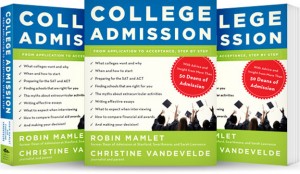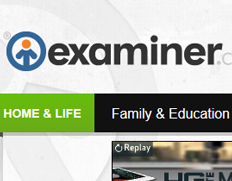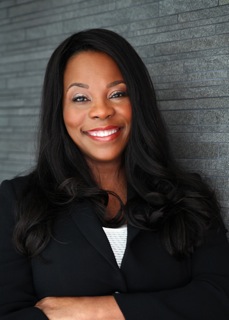A Good Reminder...
Posted on Sun, 06/10/2012 - 17:03A good reminder of what applying to college is really about for many, many students. Senait’s family came to the U.S. from Eritrea, Africa, in 1993. Watch here as she finds out she will be the first in her family to attend college. It's a "Heartwarming Tearjerker," as The Daily What aptly titles their post.
College Admission Is Going to China
Posted on Fri, 06/08/2012 - 15:04Co-Author Robin Mamlet will embark on a speaking tour of China in June, addressing students and their families about applying to college in the United States. She'll be covering the basics -- testing, essays, and aid -- as well as the particulars required of international students, such as certification of finances and translation of documents in Shanghai, Nanjing, Beijing, Guangzhou, and Shenzhen. Stay tuned for pictures of her travels here later this month.
College Admission in Fifth Printing
Posted on Thu, 06/07/2012 - 00:25 College Admission has gone into a fifth printing in less than a year! And look for us at your neighborhood Barnes & Noble in July and August. B&N has selected College Admission as part of its “Get Ready For School” campaign! Thank you to our readers -- students, parents, and counselors -- for your support and confidence in our book. And thank you to our teams at Crown Books and ICM.
College Admission has gone into a fifth printing in less than a year! And look for us at your neighborhood Barnes & Noble in July and August. B&N has selected College Admission as part of its “Get Ready For School” campaign! Thank you to our readers -- students, parents, and counselors -- for your support and confidence in our book. And thank you to our teams at Crown Books and ICM.
College Board Releases Guide for Undocumented Students
Posted on Mon, 06/04/2012 - 17:51A guide for high-school students who are also illegal immigrants is now available from the College Board. Organized state-by-state, the 55-page guide provides information on admission, financial aid and scholarships, and support services for undocumented students. According to an article in The Miami Herald, James Montoya, vice president for relationship development at the College Board, the plan is the guide will be a "living document" with constantly updated information.
College Admission talks Essays at AskJohnAboutCollege
Posted on Mon, 06/04/2012 - 17:30 We're guest blogging at John Carpenter's AskJohnAboutCollege.com! Visit us and see what we've got to say about getting started on college essays in Your College Essay -- Done!
We're guest blogging at John Carpenter's AskJohnAboutCollege.com! Visit us and see what we've got to say about getting started on college essays in Your College Essay -- Done!
Ralph Figueroa, Albuquerque Academy
Posted on Fri, 06/01/2012 - 17:02 Ralph Figueroa is Director of College Guidance at Albuquerque Academy in New Mexico, an independent day school serving approximately 1,100 students in grades six through twelve. As Figueroa describes it, Albuquerque Academy provides its students with the high-powered college preparatory education of a selective school but with the less anxious attitude that typifies New Mexico. “It’s not high-pressure,” he says. “It’s not frenetic about the college process, kids are much more open to opportunities and options and there aren’t the huge family pressures you sometimes see other places.”
Ralph Figueroa is Director of College Guidance at Albuquerque Academy in New Mexico, an independent day school serving approximately 1,100 students in grades six through twelve. As Figueroa describes it, Albuquerque Academy provides its students with the high-powered college preparatory education of a selective school but with the less anxious attitude that typifies New Mexico. “It’s not high-pressure,” he says. “It’s not frenetic about the college process, kids are much more open to opportunities and options and there aren’t the huge family pressures you sometimes see other places.”
College Admission in Examiner.com
Posted on Fri, 05/25/2012 - 19:04 Thank you to Lauren Starkey, the National College Admissions Examiner for examiner.com, for her review of College Admission: From Application to Acceptance, Step by Step. Lauren is the author of 21 books, specializing in education and business, and the parent of a newly minted college graduate!
Thank you to Lauren Starkey, the National College Admissions Examiner for examiner.com, for her review of College Admission: From Application to Acceptance, Step by Step. Lauren is the author of 21 books, specializing in education and business, and the parent of a newly minted college graduate!
Hiring an Independent College Counselor
Posted on Wed, 05/23/2012 - 18:37 Independent counselors— also sometimes called “consultants”—work outside of the high school and are not employed by a school or school district, providing private fee-based services directly to students and their families. Hiring an independent counselor may benefit some students, the particulars of which we discuss extensively in Chapter 4, College Counselors and Advisors, in our book.
Independent counselors— also sometimes called “consultants”—work outside of the high school and are not employed by a school or school district, providing private fee-based services directly to students and their families. Hiring an independent counselor may benefit some students, the particulars of which we discuss extensively in Chapter 4, College Counselors and Advisors, in our book.
The issue of whether to hire an independent counselor is complex and parents should consider carefully the costs and benefits to their family and the student’s future. For those families who have thought through the matter carefully and decide to hire an independent counselor, consultant Todd Johnson joins us today as a guest blogger to discuss how families can begin that process:
Not everyone needs an independent or private college admission counselor. But if you are considering hiring one, how do you find the best consultant for your needs?
Media Madness: More Panicky Reporting on College Borrowing
Posted on Mon, 05/21/2012 - 19:04There was more panicky reporting on the subject of student debt last week in the New York Times article, A Generation Hobbled By the Soaring Cost of College, an installation in the newspaper’s Degrees of Debt series that purports to examine the implications of soaring college costs and the indebtedness of students and their families.
As Sandy Baum and Michael McPherson of the Chronicle of Higher Education report: The New York Times made a huge statistical error in their overwrought article about higher education borrowing on Sunday. They reported that 94 percent of bachelor’s graduates leave college with educational debt. The correct number is around two-thirds. Few people will see the correction tucked into Wednesday’s Times – certainly not nearly the number who saw the lead sentence on the web version “Nearly everyone pursuing a bachelor’s degree is borrowing money …”.
Diversity: Healthcare leader Myrtle Potter's "Aha Moment"
Posted on Thu, 05/17/2012 - 18:57 Today we are joined by Myrtle Potter, one of America's foremost healthcare leaders and former president of Genentech, for a third installment in our series on the subject of diversity, featuring the personal “aha” moments of deans of admission, educators, and public figures.
Today we are joined by Myrtle Potter, one of America's foremost healthcare leaders and former president of Genentech, for a third installment in our series on the subject of diversity, featuring the personal “aha” moments of deans of admission, educators, and public figures.
In the wake of the Supreme Court’s agreement to hear a case challenging the University of Texas’ admission policy, we wanted to examine the role diversity plays in college admission. Why do colleges value diversity? Is it a worthwhile goal? What are its implications – pro and con? It is a subject that is complex, sometimes divisive, and often not well understood by students and parents.
Myrtle Potter, with her considerable experience in the world of corporate strategy, product development, and consulting, continues the discussion here:
My “aha” diversity moment may have begun in college but the lesson I was to learn didn't fully develop until years later.
I grew up in a small town in southern New Mexico. My friends and I still refer to our wonderful upbringing as a “bubble existence." We attended an incredibly diverse high school -- all races, religious backgrounds, sexual orientations and levels of income. Yet, there was no divide that separated us. The lines between lunch tables, friendships and opportunities were a colorful blur of acceptance.







